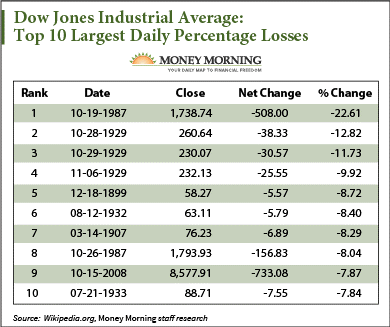Yesterday, on Feb. 5, 2018, stocks saw their largest single-day losses for the Dow (in terms of points) since August 2011.
At one point the Dow fell nearly 1,600 points before climbing back to finish the day down 1,175 points, or -4.6%.
All told, since peaking at 26,616.71 on Jan. 26, the Dow Jones fell 8.5%, to 24,345, by Feb. 5. While the drop had many on Wall Street panicking, that's technically not even considered a correction, which is defined as a drop of more than 10%.
And despite these losses, this isn't even close to the worst percentage drop in Dow history...
Here are the 10 largest one-day percentage plunges in U.S. stock market crash history...

Here's a closer look at the largest-ever percentage drop for the Dow, plus our best advice on how to weather such a volatile market...
What Triggered the Top Single-Day Stock Market Crash
The largest-ever percentage loss for the Dow, of 22.6%, on Oct. 19, 1987, is infamously known as "Black Monday."
That day, global markets came crashing down starting in Hong Kong, then spreading to Europe, and finally reaching U.S. markets. (Note that Australia and New Zealand call this day "Black Tuesday" because of the time zone difference.)
Most believe the cause of Black Monday was what is known as "program trading."
Program trading is a type of securities trading where groups of 15 stocks or more are traded simultaneously via computer programs. Larger institutions use this method when they wish to quickly trade a large number of stocks at the same time, or to take advantage of a window of price discrepancies between markets - known as arbitrage.

And as you might imagine, the increased prevalence of computer-driven program trading has made markets more susceptible to sudden corrections than ever before.
While that certainly sounds intimidating, we'd much rather take more frequent 4.6% down days than a rare 22.6% stock market crash.
Urgent: Feds use obscure loophole to threaten retirees. If you have a 401(k), IRA, or any type of retirement account, this could cause you to miss out on $68,870 or more. Learn more...
In fact, Money Morning Chief Investment Strategist Keith Fitz-Gerald predicted we'd see a market pullback in Q1 2018. And he doesn't expect the market to turn bearish as a result.
"It's important to remember that the underlying fundamentals we track so closely are not changing as fast as prices are dropping," Fitz-Gerald said. "In fact, they're going in the opposite direction, which means that profits are never far behind."
Still, sudden drops like we've seen this week are enough to make any investor nervous. That's why we're bringing Money Morning Members three ways to hedge against this volatility today...
How to Protect Your Portfolio from a Stock Market Crash
[mmpazkzone name="in-story" network="9794" site="307044" id="137008" type="4"]
Fitz-Gerald's hedges include S&P 500 inverse and short funds as well as the most traditional hedge out there, gold.
The Rydex Inverse S&P 500 Strategy - Investor Class (RYURX) rose 4.2% on Feb. 5, while the ProShares Short S&P500 (NYSE Arca: SH), an ETF alternative, also tacked on 4.20%.
As you can see, these investments move opposite to the S&P 500, making them an easy way to hedge against downside risk.
The third option is investing in SPDR Gold Shares (NYSE Arca: GLD), which is a classic hedge against market and political turmoil that doesn't move inverse to the S&P 500 - meaning that once stocks turn around, GLD shares won't necessarily start falling. On Feb. 5, the fund only rose 0.25%, but most importantly, it didn't lose ground as the broader market declined.
But it's important for investors to remember that stocks don't climb forever, and they don't fall forever.
This is only the first step of our four-step stock market crash protection plan for your portfolio. Click this link for the rest...
20 Triple-Digit Winners in the Books... and Counting
Keith Fitz-Gerald's Money Map Report subscribers who followed along with his recommendations took down 20 triple-digit winners last year - including a 201.68% return and 132.35% gain that closed out in the same week.
Two days into 2018, they closed another triple-digit winner worth 276.92%.
Each week, Keith shows everyday Americans how to tap into the world's biggest high-profit trends, ahead of the crowd.
There's nothing complicated or overly risky - and no guesswork involved.
Right now, he's looking at another double-your-money opportunity, and there's still time to find out how to subscribe and access all of Keith's recommendations by clicking here now.
Follow Money Morning on Twitter @moneymorning, Facebook, and LinkedIn.


